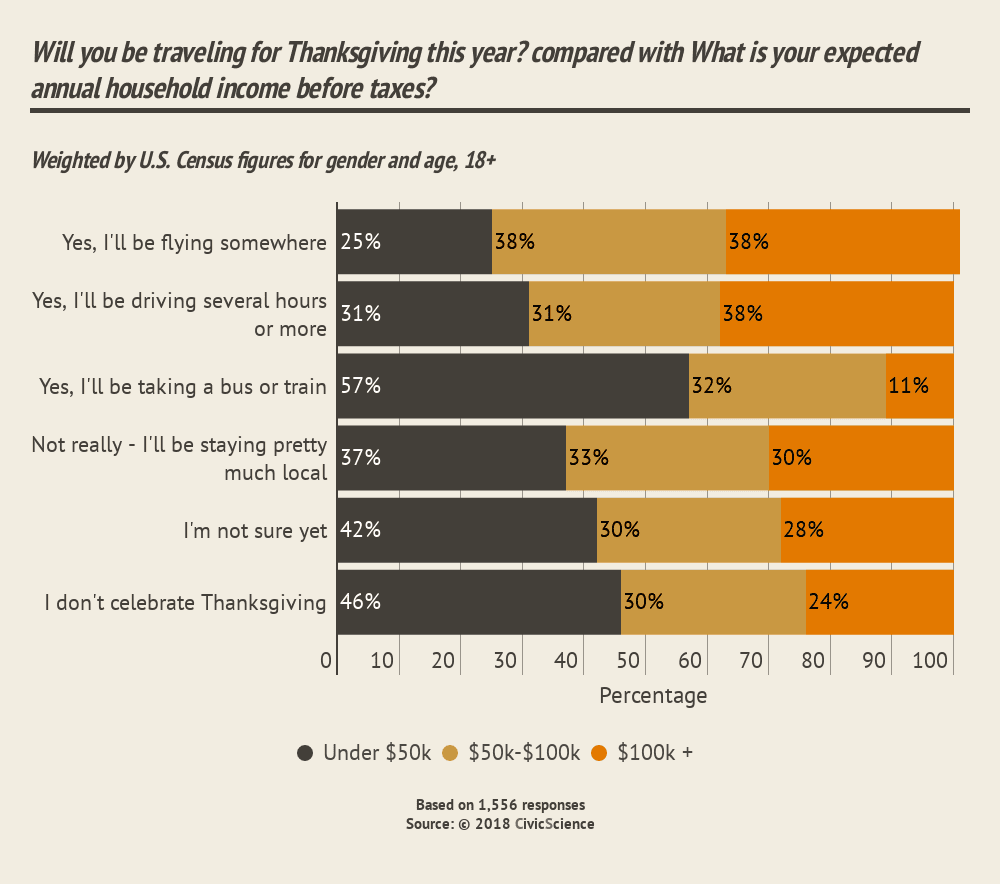The week of Thanksgiving is notorious for being some of the worst travel days of the year. With many seeking to find the best day to travel that week, CivicScience asked 1,929 U.S. adults about their Thanksgiving travel plans this year. The statistics show that 72% of U.S. adults are avoiding planes, trains, and automobiles by staying close to home. Those who are not staying local are either driving several hours or haven’t quite decided.
10% of the population planning to drive may not sound like much, but, when it comes to holiday travel, plans can change. Those who aren’t sure at the moment may opt to drive–especially as flight and train tickets continue to increase–meaning that there may be some last-minute decisions to hit the road. Drivers who know they’ll be behind the wheel should take this as a warning–they won’t be the only ones on the road when they head out later this month.
The Relationship Between Gender and Travel Plans
Although Thanksgiving travel may not initially come across as a gender-specific activity, the data explains that how we travel does vary according to gender. Those who are staying close to home are split down the middle. However, women are more likely than men to take a flight, while men are more likely to get behind the wheel.
As for those who aren’t quite sure, women make up 55%. This statistic is a gentle nod to data from earlier this year, where it became clear that women do not consider themselves quick and confident decision makers. Perhaps the fear of better options is a thread that does carry over into Thanksgiving travel plans, as well.
Thanksgiving Travel Isn’t Cheap
One factor that carries significant weight in the decision to travel could also be income. Given the high price of airfare, it would be logical for this particular type of travel to attract a certain affluent crowd. However, generally speaking, flying is equally split amongst low, middle and high-income earners.
Driving several hours, is, in fact, more common amongst high-income earners, while indecision is more common among those at the lower end of the income spectrum. As for those who are staying pretty much local, low-income earners also have a slight lead.
Living Alone Has its Price
Of course, the heart of the holiday is about spending time with loved ones and expressing gratitude. As a result, living situation is another factor to consider when evaluating travel plans. Those who live alone, are, in fact, very likely to fly, while those with 2-3 people in their home are the most likely to be staying put (or driving).
While this question does not factor in whether respondents–especially those who are staying home–have family nearby, the fact that those who live alone are also very likely to fly could suggest that the correlation between living situation and distance from family is a relevant one during the Thanksgiving travel season.
Age Brings Stability
With this in mind, it seems only natural that staying local would increase with age. At every stage of life, respondents increasingly report their growing intention to remain close to home. Whether due to stronger familial or community roots, or greater difficulty traveling long distances, the intention to stay local grows steadily until the age of 64, at which point, indecision experiences a slight growth.
It is also worth noting a small but very present group of young people who choose not to celebrate Thanksgiving at all. 11% of 25-29-year-olds indicated they will be skipping the holiday altogether. 8% of 18-24-year-olds say the same. This is worth paying attention to, especially considering the fact that it is a relatively new stance, one largely not seen amongst those 30 and up.
There are several reasons that young adults may be boycotting Thanksgiving, but regardless of the cause, if their numbers continue to grow, their choices could have an important impact on holiday travel in the years to come.
Staying Home, Staying In
As it turns out, the decision to stay local could also be linked to a decreased desire to leave the house. 34% of those choosing to remain close to home for Thanksgiving this year also reported a decreased desire to leave the house in the past six months. By contrast, 45% of those who plan to fly experienced an increase in their desire to get out. That said, those planning to fly are in the only category where the desire to leave the house has increased. For everyone else, it seems the allure of home base is real.
By and large, U.S. adults are choosing to stay close to home this Thanksgiving. However, with 15% of the population already aware of their travel plans and 8% undecided, that means up to a quarter of U.S. adults could take to the roads, railways, and skies in the days around November 22. So, regardless of whether the trip is a couple thousand miles or a couple of blocks, travelers will still be in good company when they set out.














